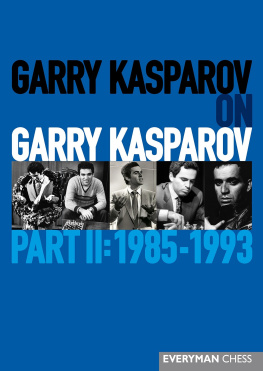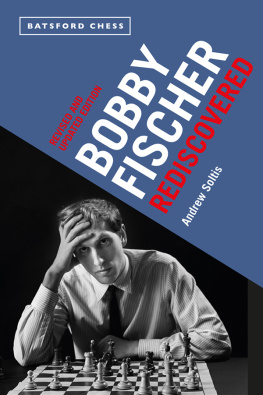Introduction
Stars of the West
The lives and games of ten chess kings of the past, from Steinitz to Spassky, have already been described, and now it is the turn of the eleventh the phenomenal Fischer, who in the early 1970s succeeded on his own in smashing the Soviet chess machine. Before him, unsuccessful attempts had been made to do this by other bright stars from the West Reshevsky, Najdorf, Larsen ... Narrative logic or perhaps Caissa herself suggested the solution of devoting an individual volume to all these outstanding players.
It stands to reason that Fischer did not emerge out of nothing. Not without reason was he called the best pupil of the Soviet Chess School, the flourishing of which led to the rapid development of the game in the mid-20th century, but with even more foundation he can be regarded as the successor to the great traditions of American chess, stemming from the legendary Morphy. Over the period of more than a hundred years separating their world triumphs, an almost continuous rise in the popularity of chess in America has been observed.
It was here that Steinitz accomplished his unparalleled feats, playing five matches for the world championship between 1886 and 1894, and more important expounding in his International Chess Magazine (1885-91) and his fundamental work Modern Chess Instructor (1889) the teachings of the new, positional school. At the end of the 19th century this wave swept Pillsbury towards the top, followed in the early 20th century by Marshall. America became a serious chess centre and it was no accident that Lasker lived here for several years, publishing his famous Laskers Chess Magazine (1904-09), just as it was no accident that the genius Capablanca appeared and grew up here, settling for a long time in New York.
While the First World War was raging in Europe, in America tournament life continued, and imperceptibly, little-by-little, the foundation for a new breakthrough was laid. In the 1920s this process was accelerated by the sensational exhibitions of the child prodigy Sammy Reshevsky, a tour by Alekhine, the challenger to the chess throne, and especially the grandiose New York tournaments (1924 and 1927). And, as a result, in the early 1930s there appeared a whole group of strong masters Kashdan, Horowitz, Steiner, Dake, Denker and others, to say nothing of the stars of world magnitude Reshevsky and Fine (to whom one of the sections in this book is also devoted). Together with the veteran Marshall, the Americans won four successive Olympiads at that time.
Meanwhile, behind the iron curtain in the USSR, where chess enjoyed state and political support, the chess machine that after the Second World War was for a long time to conquer the whole world was rapidly gathering speed. The first direct confrontation, the USSR-USA radio match on ten boards (1945) ended in a crushing defeat for the Olympiad champions.
What has happened to American chess? wrote Arnold Denker at that time. Is it possible that the country which produced the brilliant Marshall, the resourceful Reshevsky and the encyclopaedic Fine has gone back as much as the Russian trouncing would indicate? About 1932 this country had fifteen or twenty very talented young masters. What has happened to all these budding stars? Is it possible that so much talent can have dwindled away disappointingly in a few years? The answer to the second question is a clear and unequivocal Yes! Why? Because professional chess requires a players full time, and yet it does not assure him anywhere near an adequate income. Chess is a full time job, and we must treat it as such if we are to hold out own in world competition. The sooner the American chess public realizes this, the sooner we will regain our prestige as the leading nation in the world of chess.
Alas, the American chess public was in no hurry to understand this judging at least by the fact that Fine was forced to withdraw from the world championship match-tournament (1948). After this Reshevsky remained practically alone against the Soviet cohort (subsequently his experience came in very useful to Fischer). Until the end of the 1950s he was the undisputed No.1 in the West, although in the USA a new group of talented players had grown up: Evans, the Byrne brothers, Bisguier, Lombardy ...
The only player who could contest Reshevskys leadership was the Argentine grandmaster Miguel Najdorf. The point is that in the post-war era another super-power was created on the chess map Argentina, where many masters stayed on and settled after the Olympiad in Buenos Aires (1939). The strongest of them was Najdorf, who was the same age as Reshevsky and was also born in Poland, but left it 20 years later.
These two the modest, religious Reshevsky, and the cheerful, sociable Najdorf introduced western colour into top-ranking chess, which was dominated by representatives of the USSR and the Eastern Bloc countries. Strictly speaking, both of them were amateurs, since they earned a living not from chess (it seems to me that the 1961 Reshevsky-Fischer match deserves to be called the last amateur against the first professional). But the strength and natural talent of both were so great, that even when they were nearly 60 years old they were among the ten best grandmasters selected for the Rest of the World team in the Match of the Century (1970).
Worthy successors to the mighty veterans of the West appeared only in the late 1950s to early 1960s. The first to announce himself was the young Bobby Fischer, and then came the Dane Bent Larsen. Larsens tournament successes and his fresh, inventive play from 1964 to 1970 enabled him even to take from Fischer his lawful first board in the aforementioned Match of the Century. At that time only these two posed a threat to the Soviet hegemony. However, soon Fischer brilliantly showed that it was he who was destined to become the new world champion. His revolutionary breakthrough and tragic departure from chess are the main topic of this book.















